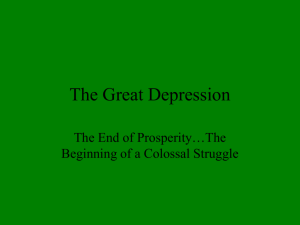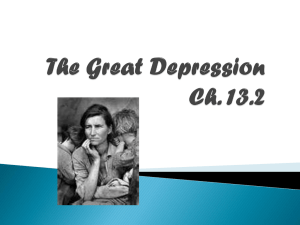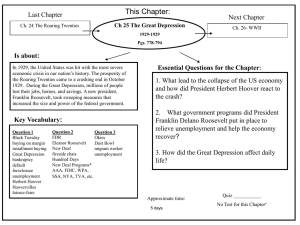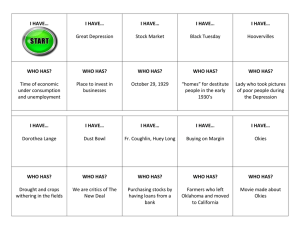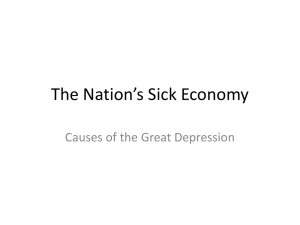The Great Depression Introduction
advertisement
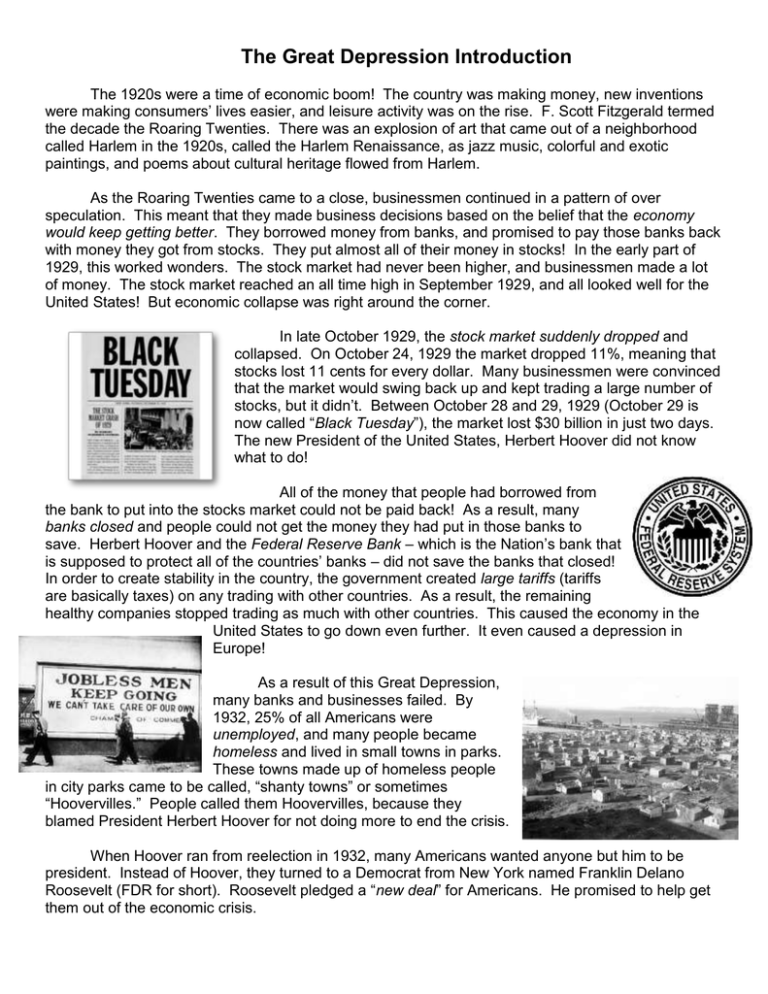
The Great Depression Introduction The 1920s were a time of economic boom! The country was making money, new inventions were making consumers’ lives easier, and leisure activity was on the rise. F. Scott Fitzgerald termed the decade the Roaring Twenties. There was an explosion of art that came out of a neighborhood called Harlem in the 1920s, called the Harlem Renaissance, as jazz music, colorful and exotic paintings, and poems about cultural heritage flowed from Harlem. As the Roaring Twenties came to a close, businessmen continued in a pattern of over speculation. This meant that they made business decisions based on the belief that the economy would keep getting better. They borrowed money from banks, and promised to pay those banks back with money they got from stocks. They put almost all of their money in stocks! In the early part of 1929, this worked wonders. The stock market had never been higher, and businessmen made a lot of money. The stock market reached an all time high in September 1929, and all looked well for the United States! But economic collapse was right around the corner. In late October 1929, the stock market suddenly dropped and collapsed. On October 24, 1929 the market dropped 11%, meaning that stocks lost 11 cents for every dollar. Many businessmen were convinced that the market would swing back up and kept trading a large number of stocks, but it didn’t. Between October 28 and 29, 1929 (October 29 is now called “Black Tuesday”), the market lost $30 billion in just two days. The new President of the United States, Herbert Hoover did not know what to do! All of the money that people had borrowed from the bank to put into the stocks market could not be paid back! As a result, many banks closed and people could not get the money they had put in those banks to save. Herbert Hoover and the Federal Reserve Bank – which is the Nation’s bank that is supposed to protect all of the countries’ banks – did not save the banks that closed! In order to create stability in the country, the government created large tariffs (tariffs are basically taxes) on any trading with other countries. As a result, the remaining healthy companies stopped trading as much with other countries. This caused the economy in the United States to go down even further. It even caused a depression in Europe! As a result of this Great Depression, many banks and businesses failed. By 1932, 25% of all Americans were unemployed, and many people became homeless and lived in small towns in parks. These towns made up of homeless people in city parks came to be called, “shanty towns” or sometimes “Hoovervilles.” People called them Hoovervilles, because they blamed President Herbert Hoover for not doing more to end the crisis. When Hoover ran from reelection in 1932, many Americans wanted anyone but him to be president. Instead of Hoover, they turned to a Democrat from New York named Franklin Delano Roosevelt (FDR for short). Roosevelt pledged a “new deal” for Americans. He promised to help get them out of the economic crisis. FDR defeated Hoover in a landslide victory. Americans wanted a New Deal, and so in his first 100 days in office, Roosevelt gave one to them. He created government work programs, like the Tennessee Valley Authority (TVA) and the Civilian Conservation Corps (CCC) among many others. These organizations made improvements to America’s roads and infrastructure. They gave many Americans jobs. He also set up a system called Social Security. Social Security would take a little money out of the paychecks of workers, and the workers would get that money back when they retired. That way Americans would still have some savings if banks collapsed. FDR also created the environmental improvement programs (TVA did this), farm assistance programs (to help farmers get back on their feet), and gave workers increased rights. His New Deal was designed to help America get out of the Great Depression. In spite of the New Deal, America remained in a Great Depression for all of the 1930s. They had to make due with much less than they had to begin with. The Roaring Twenties were over, and the Great Depression of the 1930s forced Americans to live with less money and less wealth. America would continue in this Depression until the early 1940s, when another great event would force factories to work extremely hard. We’ll talk about that next unit. Review: 1. Identify 2 causes of the Great Depression and explain both. 2. Who was the president when the Great Depression began? Who became president in 1932? 3. Write one word to summarize the Great Depression and one sentence explaining why you choose that word. 4. What was the New Deal? List three programs created under the New Deal. 5. Predict: what great event would force factories to work extremely hard and bring America out of the Great Depression?
